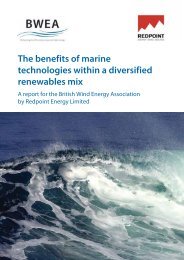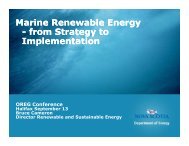Water Current Turbines for River Applications - Alaska Energy ...
Water Current Turbines for River Applications - Alaska Energy ...
Water Current Turbines for River Applications - Alaska Energy ...
- No tags were found...
You also want an ePaper? Increase the reach of your titles
YUMPU automatically turns print PDFs into web optimized ePapers that Google loves.
WCT Evaluation3 Companies and TechnologiesNRCan-06-010713.1 Survey of Established and Emerging WCT CompaniesFor this report, Verdant Power per<strong>for</strong>med an extensive web-based search and reviewed and updatedearlier research per<strong>for</strong>med <strong>for</strong> the Electric Power Research Institute in 2004. Although this reportfocused on WCT technologies <strong>for</strong> rivers, the search first entailed locating all WCT companies,regardless of their site application. Once the companies were identified, the site application of theirtechnology was determined: non-tidal rivers (NTR), tidal areas (rivers or straits), and unidirectionalocean currents.In many cases WCT technologies are suitable <strong>for</strong> multiple site types. The most critical factor <strong>for</strong>whether a tidal system can be applied in a non-tidal application is unit size. The most well publicizedtidal technologies to date have been large systems that need 20 m or more of depth to operate (e.g.,Marine <strong>Current</strong> Turbine, Hammerfest-Strom, and The Engineering Business), where the economy ofscale theoretically improves the profitability of development. This limits their applicability in a majorityof non-tidal rivers. However, many of the devices may have the potential to be scaled down to fit abroader range of river flow and depth characteristics.For purposes of this report, we have attempted to identify technologies by their applicability to NTR’s asopposed to the developer’s current market focus. The report emphasizes technologies that are currentlyscaled to 1 kW or more. Each vendor’s stage of development is noted; the stages may be defined asfollows:Laboratory: Scale model testing in a laboratory settingPrototype: Single unit field testPre-commercial: Demonstration of commercial size unitsCommercial: Units commercially availableRecent and rapid developments in the WCT industry make separating verifiable technical data fromsubjective or promotional public statements a serious challenge. Third-party verification of technicalclaims, especially quantitative per<strong>for</strong>mance data, is minimal at present, so in<strong>for</strong>mation about sometechnologies is based primarily on qualitative descriptions from the developers. Some of the newestdesigns are literally just emerging from laboratory secrecy. For the purposes of this report, the authorshave chosen to include developers’ claims where third party verification is not available in order toprovide NRCan with in<strong>for</strong>mation on the broadest range of technologies.Verdant Power Canada ULC9










